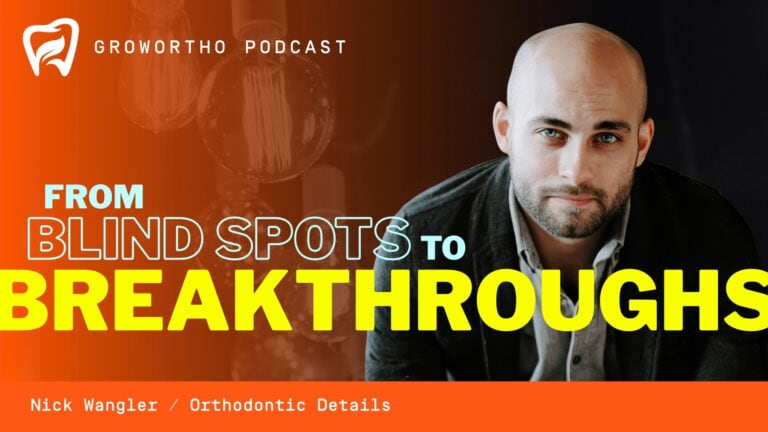Subscribe: RSS
Ever watch a patient nod politely through your treatment presentation, then disappear forever? You’re not alone. Most orthodontic practices accept mediocre case acceptance rates as “industry standard.” Here’s the truth: your 50% conversion rate is costing you over $200,000 annually in lost revenue.
Brooke Oliphant learned this the hard way. As a treatment coordinator following rigid scripts, she hit the industry average and felt stuck. Her breakthrough came when she ditched the fill-in-the-blanks approach and started treating consultations like human conversations. The result? Conversion rates that consistently hit 80% and beyond.
Your consultation process has five hidden friction points that are killing your case acceptance. Fix these, and you’ll transform tire-kickers into committed patients.
The Script Prison: Why Rigid Conversations Kill Confidence
Confidence sells. Scripts don’t.
Walk into most practices and you’ll hear treatment coordinators reciting the same rehearsed lines, word for word. The moment a patient asks something unexpected, panic sets in. They freeze, defer to the doctor, or worse, fumble through an obviously scripted response.
Here’s what’s really happening: confidence is contagious, and so is uncertainty.
When your TC loses confidence, patients feel it instantly. They start questioning your expertise before you’ve even talked about treatment. Scripts create this problem by making team members dependent on perfect conditions that rarely exist in real conversations.
Think about your best treatment coordinator. They don’t sound robotic because they’ve moved beyond scripts to frameworks. They have structure without handcuffs. They can pivot when a parent asks about payment options or when a teen shows resistance to braces.
The framework approach works like this: Know your key talking points, understand the logical flow, but speak like a human being who genuinely wants to help. When patients sense authenticity instead of a sales pitch, they lean in rather than pull back.
The Redundancy Trap: How Repeating Information Destroys Trust
They already told you three times. Start listening.
Picture this scenario: A parent calls your office and explains their child needs braces. They fill out new patient paperwork detailing the same concerns. Then your treatment coordinator starts the consultation with “So, what brings you in today?”
You just told them their time isn’t valuable enough for you to prepare.
Orthodontics is an attention-to-detail business. When you ask patients to repeat information they’ve already provided, you’re signaling that precision isn’t your strong suit. Why would they trust you to move their teeth correctly if you can’t manage basic information?
Preparation demonstrates clinical competence before the clinical exam begins.
The most effective treatment coordinators read scheduling notes and review paperwork beforehand. They start consultations in the middle of a conversation, not at the beginning. Instead of “What brings you in?” try “I see from your paperwork that Sarah’s front teeth are your main concern. Tell me more about what you’ve noticed.”
This simple shift proves you’re paying attention and sets a professional tone that builds trust from minute one.
Language Landmines: The Words That Sabotage Your Sales
Stop saying “just” and start commanding premium fees.
One word can destroy thousands of dollars in value perception. That word is “just.”
“It’s just phase one.” “It’s just six months.” “It’s just limited treatment.”
Every time you use “just,” you’re telling patients the service isn’t significant. Then you present a $5,000 fee and wonder why they seem shocked. You’ve spent the entire consultation diminishing the value of what you’re offering.
Your internal money beliefs leak into patient conversations.
If you think orthodontic treatment is expensive, patients will sense that discomfort the moment you mention fees. Your energy changes. Your voice gets serious. You unconsciously validate their financial concerns before they even express them.
The reframe technique works better. When a patient says “I don’t like to smile,” don’t just acknowledge it. Get excited for them: “I’m so happy you’re here. Let’s get you to a place where you’re confident and excited about smiling.”
Turn their problem into your opportunity to create transformation.
The Doctor Handoff Disaster: When Two Presentations Equal Zero Sales
If your doctor spends more than ten minutes, you have two treatment coordinators.
Here’s a scene that plays out daily: The treatment coordinator presents the case, discusses treatment options, and builds excitement. Then the doctor enters and starts over, covering the same ground with different language and potentially different recommendations.
The patient thinks: “These people don’t communicate. How can I trust them with my treatment?”
Strategic handoffs maintain momentum instead of killing it.
The treatment coordinator should introduce something specific about the patient to the doctor in front of them. “Dr. Smith, this is Sarah and her mom. Sarah plays violin and is concerned about how braces might affect her embouchure for her recital next month.”
Now the doctor has context and can build on existing conversation rather than starting fresh. The consultation maintains energy instead of losing steam through repetition.
The “parrot principle” applies here: treatment coordinators must echo their doctor’s language and treatment philosophy. When patients hear consistent messaging, they feel confident about moving forward. When they hear conflicting information, same-day decisions become impossible.
Body Language Breakdown: Why Your Physical Setup Screams “Sales Pitch”
Stop sitting across the desk like you’re negotiating a car deal.
The moment you mention fees, most treatment coordinators unconsciously shift into “sales mode.” They sit straighter, speak more seriously, and create physical barriers between themselves and patients.
You’ve just turned a collaborative healthcare conversation into an adversarial transaction.
The energy shift kills conversions faster than sticker shock.
Smart treatment coordinators maintain the same friendly, helpful energy when discussing finances. They use collaborative seating arrangements and share screens or tablets so everyone can look at information together.
Instead of presenting at patients, you’re exploring options with them. The difference is subtle but powerful. “Doing it together” energy makes people feel supported rather than sold.
When patients feel like you’re on their side rather than across from them, financial conversations become problem-solving sessions instead of negotiations.
The Three Changes You Can Make This Week
Ready to boost your case acceptance immediately? Start with these actions:
Preparation Checklist: Create a simple form for treatment coordinators to complete before every consultation. Include: reason for scheduling, specific concerns mentioned, referral source, and any special circumstances. Five minutes of prep work can increase conversion by 15 percent.
Language Audit: Record three consultations this week (with permission) and count how many times you hear “just,” “only,” or other diminishing words. Replace them with value-building language that emphasizes importance rather than minimizing it.
Physical Setup Review: Rearrange your consultation space so you can sit beside patients when reviewing treatment options and fees. If you’re stuck behind a desk, get a tablet or laptop you can turn toward them for collaborative viewing.
Your Competition Is Making These Same Mistakes
Most orthodontic practices plateau at average performance because they don’t recognize these consultation killers. They blame “price shoppers” or “difficult patients” instead of examining their own processes.
While your competitors stay stuck in mediocrity, you can implement these five fixes and create real competitive advantage. Patients are shopping around more than ever. The practice that makes them feel understood, valued, and confident will win their business every time.
Your consultation process is either building trust or destroying it. There’s no middle ground. Choose to build it, and watch your case acceptance rates climb toward 80 percent and beyond.
Start with preparation. Perfect your handoffs. Choose your words carefully. Your bottom line will thank you.
Want to improve your sales within your Orthodontic practice? Work with Brooke Oliphant personally to transform your practice: https://www.riseuporthocoaching.com/.




